It is estimated that the Great Hanshin-Awaji Earthquake forced more than 50,000 people to escape from Hyogo Prefecture. Although it has been 20 years since the disaster, it is said that many such people still continue living outside the prefecture.
According to the Reconstruction Agency, there were more than 70,000 people who evacuated from Miyagi, Fukushima and Iwate prefectures after the Great East Japan Earthquake at the time when most people had evacuated.. As of December 2014, the number of such people was still more than 50,000, and there were nearly 1,000 registered evacuees in Hyogo Prefecture. Some of them are young mothers who face many problems raising their first children in a new environment that is totally unfamiliar to them.
Bekoko MaMa is an organization for mothers and children who have been affected by the Great East Japan Earthquake and have evacuated their hometowns to Kobe to escape from the nuclear power station accident in Fukushima, and to protect the health and future of their beloved children. Ms. Kobayashi provides support as a member of the organization’s administration office.
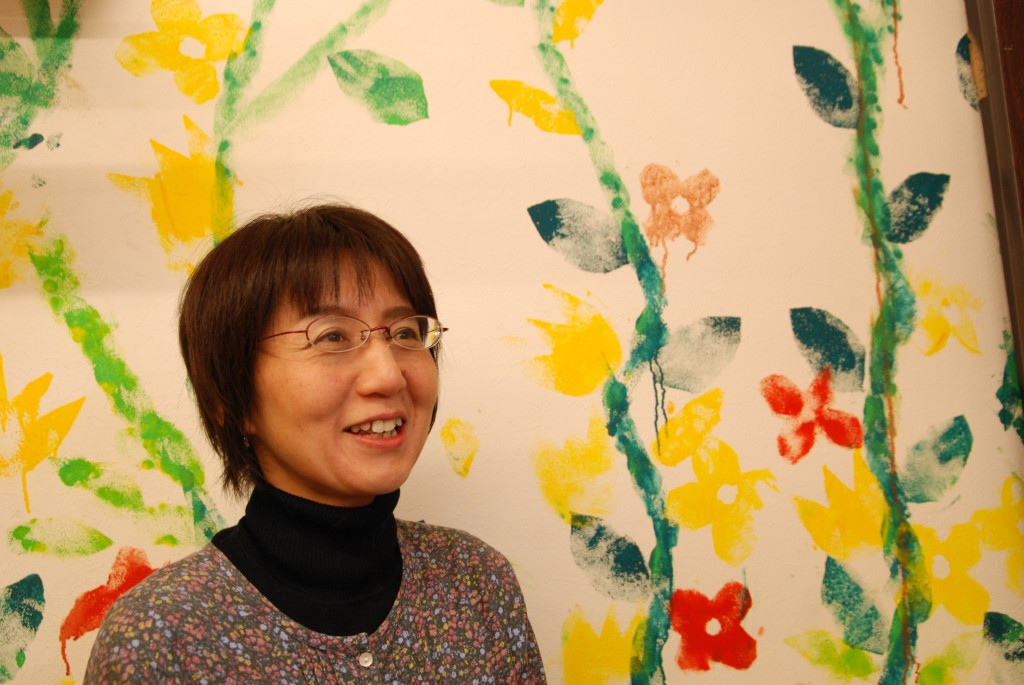 Revival of the Memories of That Day and Feeling a Sense of Mission
Revival of the Memories of That Day and Feeling a Sense of Mission
When the Great Hanshin-Awaji Earthquake hit, Ms. Kobayashi lived in Nishinomiya City. Until then, she had never experienced such strong shaking. Hearing sounds of glass shattering in the darkness, she felt as if the earth were heaving upward. She truly feared for her life.
Protecting myself with bedding, I felt my heart beating very fast. I thought that the end of the world had come. After it became light, I stood up, looked outside, and saw several columns of smoke from fires in the north. When I went outside, muddy water from liquefaction was bubbling up. The streets were full of bumps, causing vehicles to tilt.
Time went by, and another disaster struck on March 11, 2011. When watching news of the Great East Japan Earthquake on TV, Ms. Kobayashi realized that she had almost forgotten the tremendous fear that she had felt at the time of the Great Hanshin-Awaji Earthquake. She was so occupied with child-rearing and other daily chores that she seldom remembered her painful experience of the time.
Every time she learned about the disastrous situation in the Tohoku region through the media, she spontaneously felt that there must be something she could do for affected people. However, she needed to take care of her aged father-in-law and her daughter, who was in the first grade of elementary school at the time. It was practically impossible for her to leave them at home to go to the affected areas.
In this regard, she began working as a member of a project for sending relief supplies to the Tohoku region. She was engaged in sorting relief items. It was in late March, right after the occurrence of the Great East Japan Earthquake.
Each Encounter Forming Ties
Around June, the peak period of sending relief supplies to affected areas ended, although many donated items remained in warehouses. Accordingly, it was decided that such items would be provided to evacuees in Kobe.
Some of those who came to us to receive items were mothers carrying their newborn babies in their arms. Then, some staff members working with me said “Ms. Kobayashi, you are from an NPO providing child-rearing support, aren’t you? Is there anything that you can do for them?” So I talked about this with Ms. Nishimori from With Nature.
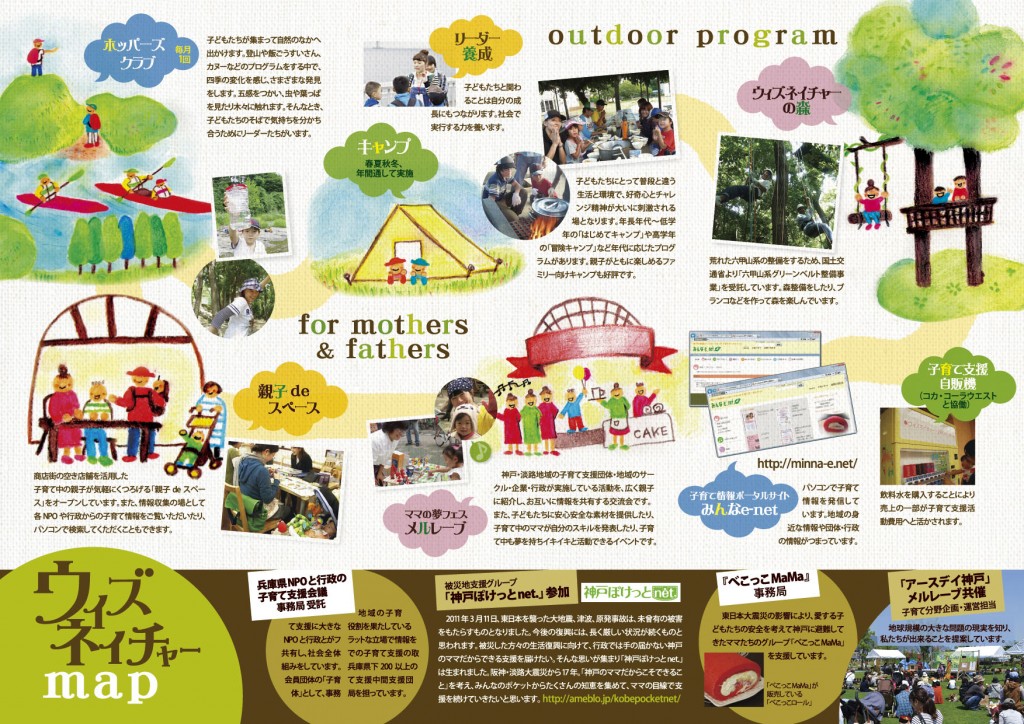 Photo: With Nature is an NPO providing support for outdoor activities and child-rearing. Since her daughter, who was in the first grade of elementary school back then, participated in this NPO’s activities, Ms. Kobayashi was involved with the organization as a parent.
Photo: With Nature is an NPO providing support for outdoor activities and child-rearing. Since her daughter, who was in the first grade of elementary school back then, participated in this NPO’s activities, Ms. Kobayashi was involved with the organization as a parent.
It was around that time that a maternity clinic also asked With Nature to provide support for pregnant women who had escaped from the Great East Japan Earthquake with nothing but the clothes on their back. That was why we decided to hold an event for women in similar situations so that they could gather and talk about a wide variety of topics.
If Mothers Become Energetic, Their Children Also Become Energetic
In July 2011, Kobe Pocket net., established by five organizations in Kobe to provide child-rearing support, arranged an okonomiyaki (Japanese-style pancake) party for mothers who had individually evacuated their hometowns to Kobe. This served as the starting point of Bekoko MaMa.
Around that time, it was noted that it would take a long time before evacuees would be able to return to their hometowns. Bekoko MaMa launched activities to help mothers escaping from the disaster to become independent, with the involvement of Ms. Kobayashi in the administration office. Although Bekoko MaMa started with seven staff members, after gradual changes eight people are currently engaged in the organization.
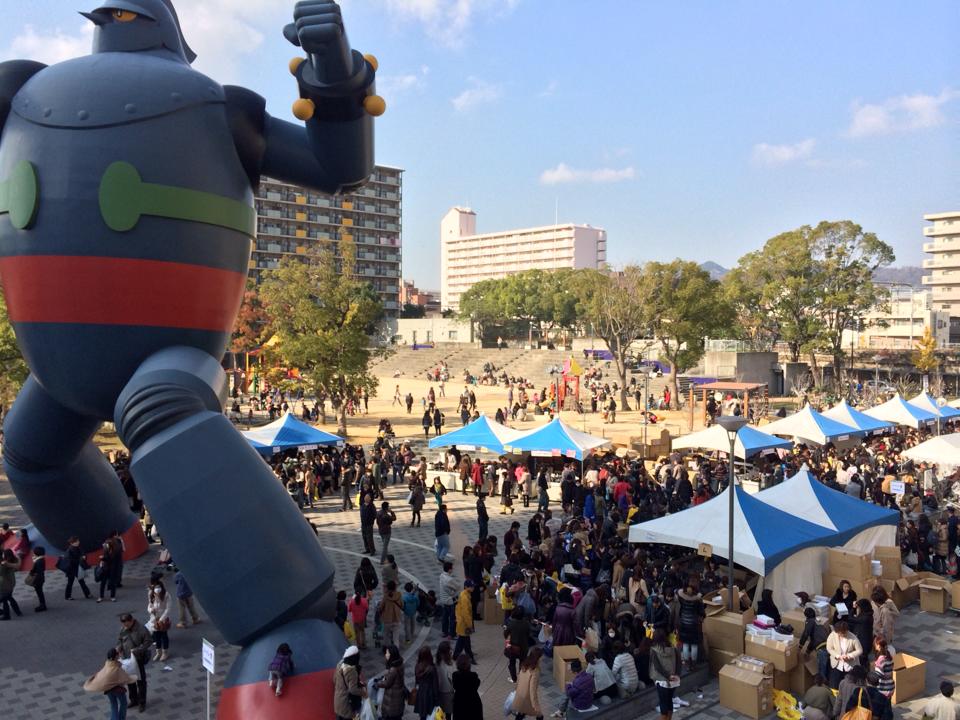 Photo: Many people visiting an event held around the life-size statue of Iron Man Number 28 in Iron Man Square in front of JR Shin-Nagata Station
Photo: Many people visiting an event held around the life-size statue of Iron Man Number 28 in Iron Man Square in front of JR Shin-Nagata Station
As its first activity, Bekoko MaMa sold items from the Tohoku region at an event held in Iron Man Square in front of JR Shin-Nagata Station. After this event, mothers living in anxiety in unfamiliar environments began to be engaged in developing new products and selling them at various events. Through these efforts, they began to regain their energy little by little. If mothers become energetic, their children also become energetic.
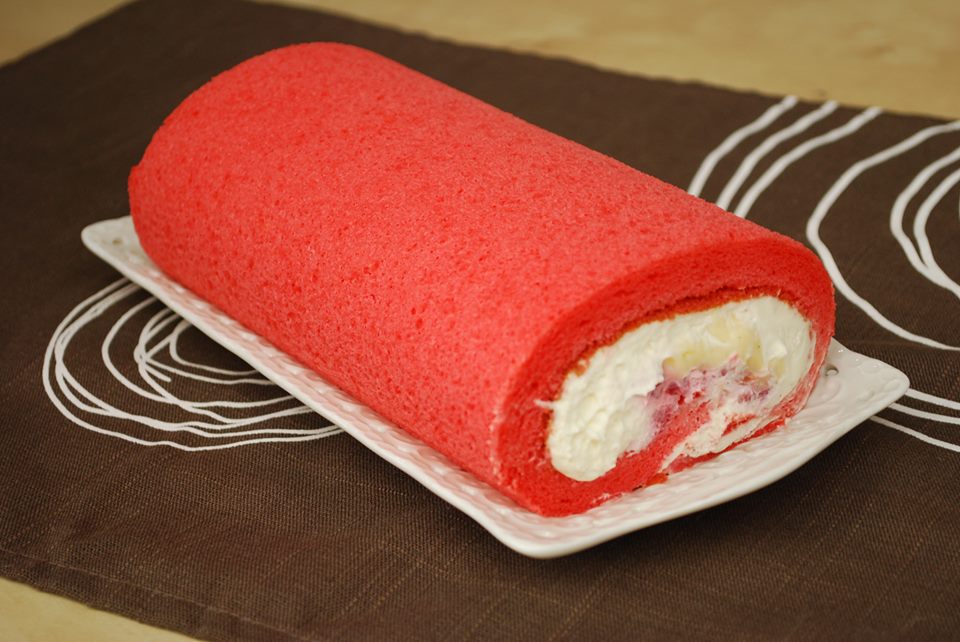 Photo: Bekoko Roll, developed through cooperation with the renowned cake shop Miyu in the former Foreign Settlement of Kobe
Photo: Bekoko Roll, developed through cooperation with the renowned cake shop Miyu in the former Foreign Settlement of Kobe
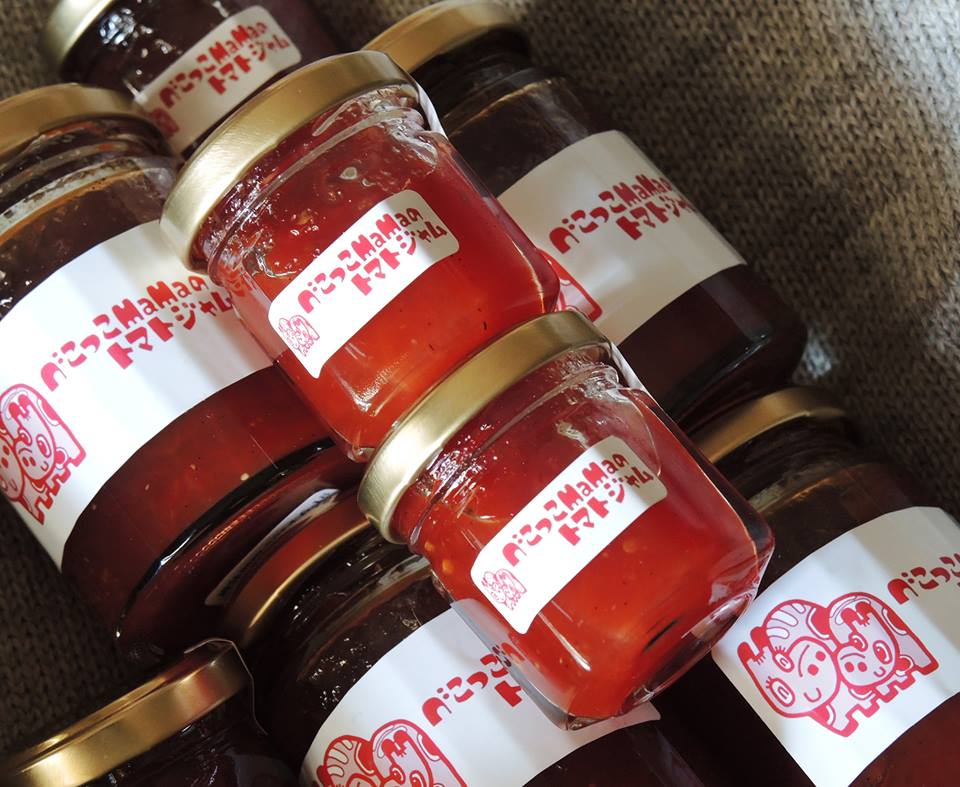 Photo: Jams, the organization’s current main products, which have been made from excellent Megumi Tomatoes, provided by Mr. Masahiko Onishi of Cal-farm Kobe, with cooperation from Mr. Akito Tanaka of Patisserie AKITO.
Well, They Can Do It!
Photo: Jams, the organization’s current main products, which have been made from excellent Megumi Tomatoes, provided by Mr. Masahiko Onishi of Cal-farm Kobe, with cooperation from Mr. Akito Tanaka of Patisserie AKITO.
Well, They Can Do It!
Currently, Bekoko MaMa holds a monthly café event, where the organization’s members, namely mothers evacuating their hometowns, prepare menu items developed from their own perspectives. The organization’s activities are frequently covered by newspapers and other mass media. With the rise of the profile of their activities, such mothers are regaining their self-confidence.
Some of the volunteer evacuees feel concerned about continuing their lives as evacuees. Family members living separately, children’s health, homes, work, money, etc. . . . they suffer endless worries.
In such a situation, if they can forge ties with people in a similar situation, they will feel reassured. Also, if their activities are recognized, it will give them self-confidence.
 Photo: Bekoko*Café, held monthly at Wina-no-mori, located on the south side of JR Shin-Nagata Station on the Rokkenmichi 5-chome Shopping Street. Original menu items are provided, developed in the hope that children will eat more vegetables.
Photo: Bekoko*Café, held monthly at Wina-no-mori, located on the south side of JR Shin-Nagata Station on the Rokkenmichi 5-chome Shopping Street. Original menu items are provided, developed in the hope that children will eat more vegetables.
At first, Bekoko MaMa needed various forms of support, but each member gradually began to take action on her own initiative.
When Ms. Goda of Wina-no-mori suggested that members of Bekoko MaMa hold a monthly café, I was worried, doubting that they could really do it. But once the project started, all of them were very energetic and enthusiastic, making me feel “Well, they can do it!”
Now that three years have passed since the establishment of the organization, I’m trying to gradually hand over my duties to members, such as office work and negotiations with those outside our organization.
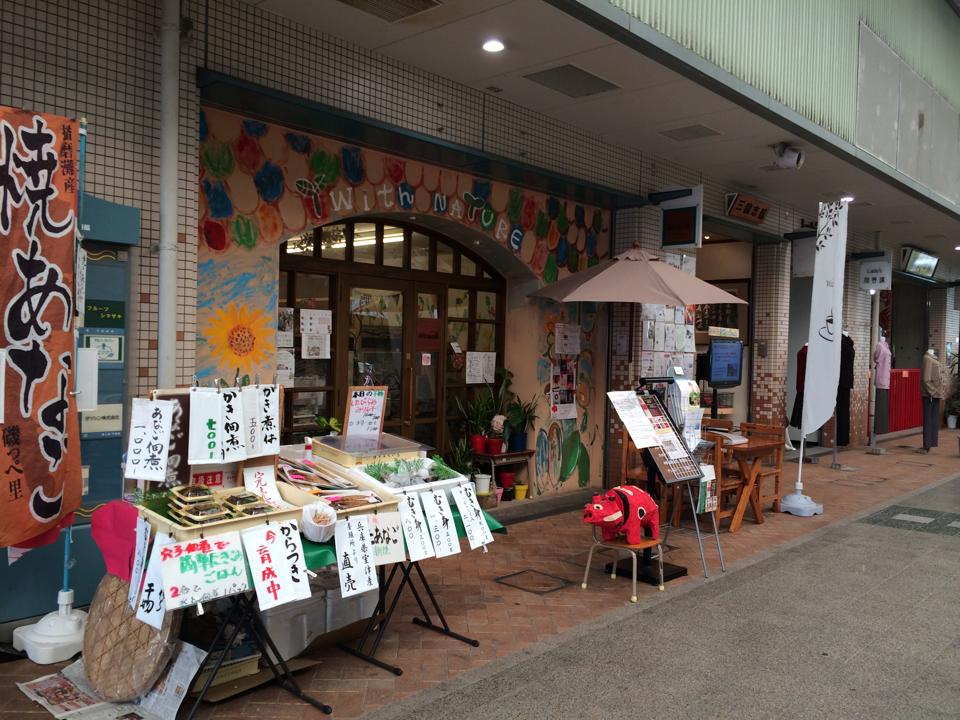 Photo: Wina-no-mori, where visitors can relax together with their children with peace of mind
Photo: Wina-no-mori, where visitors can relax together with their children with peace of mind
Bekoko MaMa has not selected a representative, in order to prevent a heavy burden from being placed on a certain person. Instead, Ms. Kobayashi in the administration office handles almost all contacts from those outside the organization. Since she was born and raised in Kobe, she acts as a good intermediary who can contribute to the organization’s smooth operations.
The ideal is that the organization will be able to carry out various activities without me in the future. Since all members work really hard, I cannot say to them any longer “Let’s work hard.” But I can say to them “I’ll continue to stay with you.” I hope to support their activities until around the time when the current members’ children will come of age.
Ms. Kobayashi has a deep perspective and a gentle attitude. This is probably because she also suffered a natural disaster and experienced difficulties in raising a child. Her daughter, who was in the first grade of elementary school when the Great East Japan Earthquake occurred, now sometimes participates in Bekoko MaMa’s activities. In addition, her husband also provides her with warm support.
Her family’s understanding and support are essential to Ms. Kobayashi’s activities. Likewise, support from local residents is critical to Bekoko MaMa. Bekoko MaMa is supported by many organizations and people, such as With Nature and Kobe Pocket net., both of which provided an opportunity for the establishment of Bekoko MaMa; Cal-farm Kobe, which supplies tomatoes for jams; volunteer child-care staff members who are indispensable for Bekoko MaMa’s holding or participating in events; and other organizations and local residents that provide generous assistance.
When one of the members was interviewed by a TV crew, she said that she owed what she was to people in Kobe. This made me teary-eyed. I’m very glad that I have been able to forge ties with them.
Ties Will Continue Even After Separation
Future visions vary depending on the mother evacuating her hometown. While some would like to return as soon as possible, others intend to continue living outside their hometowns until their children come of age. Also, some are determined to settle down in their new destinations. When implementing activities, Bekoko MaMa ensures that each member’s values are respected.
Bekoko MaMa maintains ties even with members leaving Kobe, using a mailing list. When the organization participates in an event, such members send handmade items to be sold at the event.
 Photo: Handmade items
Photo: Handmade items
It is important to carry on. If we carry on with our activities, it means an increase in the number of opportunities to let people know about the reality of the lives of evacuees. If we set up a booth at an event, it provides an opportunity for people to remember that there are still many evacuees and to know that such evacuees carry out various activities.
Regarding the name “Bekoko MaMa,” “M” represents a mother cow, while “a” represents a calf resting with its mother cow. Although they might take slow steps like cows, the organization’s members make steady steps forward. Such members’ strength and power are brought out by Ms. Kobayashi.
At Bekoko MaMa, different members have different circumstances, although they have one thing in common – a wish to protect their children. The number of members in the organization continues to increase.
(Interviewed and written by Fumie Matsuyama)
This article was created with the cooperation of
greenz.jp.
![]() an evacuee support organization staff member
an evacuee support organization staff member JP | EN
JP | EN JP | EN
JP | EN
 Photo: With Nature is an NPO providing support for outdoor activities and child-rearing. Since her daughter, who was in the first grade of elementary school back then, participated in this NPO’s activities, Ms. Kobayashi was involved with the organization as a parent.
Photo: With Nature is an NPO providing support for outdoor activities and child-rearing. Since her daughter, who was in the first grade of elementary school back then, participated in this NPO’s activities, Ms. Kobayashi was involved with the organization as a parent. Photo: Many people visiting an event held around the life-size statue of Iron Man Number 28 in Iron Man Square in front of JR Shin-Nagata Station
Photo: Many people visiting an event held around the life-size statue of Iron Man Number 28 in Iron Man Square in front of JR Shin-Nagata Station Photo: Bekoko Roll, developed through cooperation with the renowned cake shop Miyu in the former Foreign Settlement of Kobe
Photo: Bekoko Roll, developed through cooperation with the renowned cake shop Miyu in the former Foreign Settlement of Kobe Photo: Jams, the organization’s current main products, which have been made from excellent Megumi Tomatoes, provided by Mr. Masahiko Onishi of Cal-farm Kobe, with cooperation from Mr. Akito Tanaka of Patisserie AKITO.
Photo: Jams, the organization’s current main products, which have been made from excellent Megumi Tomatoes, provided by Mr. Masahiko Onishi of Cal-farm Kobe, with cooperation from Mr. Akito Tanaka of Patisserie AKITO. Photo: Bekoko*Café, held monthly at Wina-no-mori, located on the south side of JR Shin-Nagata Station on the Rokkenmichi 5-chome Shopping Street. Original menu items are provided, developed in the hope that children will eat more vegetables.
Photo: Bekoko*Café, held monthly at Wina-no-mori, located on the south side of JR Shin-Nagata Station on the Rokkenmichi 5-chome Shopping Street. Original menu items are provided, developed in the hope that children will eat more vegetables. Photo: Wina-no-mori, where visitors can relax together with their children with peace of mind
Photo: Wina-no-mori, where visitors can relax together with their children with peace of mind Photo: Handmade items
Photo: Handmade items